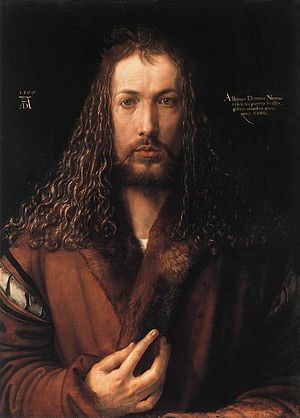 Submitted by Alchemyst on
Submitted by Alchemyst on

wikipedia.com
The puzzling Albrecht Dürer’s pen drawing portraying Apollo holding his inverted name in his hand can be often found straightened out in the net. But the German painter thought it just like that, backwards.

Discovering a flipped over painting and correcting it is outrageously easy with a computer. In fact many of the Dürer’s Apollo copies circulating in the search engines are repaired by someone loving order and wondering how on earth a sixteenth century artist could have done something so asymmetrical, and against the Renaissance decency. So, piously, they give us a chance to read the inscription without twisting our necks. And to provide this service they do not hesitate to invert the symmetry of the anthropomorphic figure, in this going really against the basic laws of the classical and Renaissance symmetry, according to which figures always do their action to the right of the observer, this being a basic rule of art courtesy of all times ( which even Picasso used to do when deconstructing painting).
But the modern purists of symmetry fail to grasp that is not the figure of Apollo to be overthrown, but rather his name. Renaissance painters, and especially Dürer, were known as masters of symmetry. The great German artist’s love for balance, as well as his conspicuous knowledge of mathematics, brought him to write and engrave his famous treatise “Della Simmetria dei Corpi Humani” or “On the symmetry of human bodies” (Italian edition Venice, 1594), a precise and obsessively detailed guide on how to respect the equilibrium of the human body (along with many other intriguing implications) and make it harmoniously in any artistic as well as architectonic situation. A must for every painter of the time. So, to an art connoisseur, Dürer would be the last Renaissance painter to flout the symmetry law.
Additionally, Albrecht Dürer has always been known as an aesthete who loved the perfect rendering of the reality, more than being a fanciful story-teller. In fact, since his beginnings, he put on display evidences of his extreme accuracy of details and conformity to real, as we can see from a watercolor of Innsbruck castle he painted in 1494, in his way to Venice. So he definitely could not have left behind a joke like a backwards name with no deep reason. In fact in his Apollo’s portraying he not only respected the symmetry of the anthropomorphic figure but also the ancient hidden Roman knowledge, according to which the Jupiter’s son name could be only written reversed, and we’ll see why. And we know how ancient Romans did love to write inverted names. But perhaps the term “backwards” appears more appropriate.
Albrecht Dürer (1471 – 1528) was the greatest Renaissance German figurative artist and one of the European greatest as well. Despite having being a remarkable painter, he is almost known for his engraving and drawing production, where he let the most outstanding signs of his esoteric knowledge; in fact his attending neoplatonic environments is a well known fact by art historians. Although Dürer’s double staying in Venice had not been long enough to suggest a deep involving in the Venetian esoteric milieus, we cannot underestimate the same environments in Germany ( perhaps less showy than Italian, but equally important). What it is surely known is that he left to us some masterpieces of Renaissance age that are the most filled with hermetic details – mainly engravings, where he could give more room to his own inspiration, rather than meeting the buyers needs.
The pen drawing we are examining is currently conserved in British Museum, and known with the full title art historians gave it: “Apollo with the Solar Disc and Diana Trying to Shield Herself from the Rays with Her Uplifted Hand”, so they even give us a description. The drawing appears to be finished only in the upper part and the figure of Apollo, but not yet fully refined concerning ( the supposed) Diana’s figure. To an extent that some critics put forward the idea that Dürer’s original purpose was the depiction of the male figure alone, who would represent the planetary god Sol/Sun. They affirm their view would be corroborated by the impressive rendering of the sun’s rays, but admittedly the celestial background, rich in painterly effect, was added at a later stage. Dürer probably drew the Apollo in 1504, and some think it was conceived as a variation on the Adam of the 1504.
The word “Apolo” is written backwards and with a view toward the engraving. The conspicuous incongruity of the inscription compared to the space allotted to it, can suggest that “Apolo” is probably a substitute for the earlier name Sol. Apparently Dürer realized too late of having committed an error, which essence we cannot grasp at the moment, but we will deepen further. The result is that god Apollo is brought out from himself, with a spectacular effect. So the inscription is surely inverted, and the main reasons are two: either for strengthening the mirroring idea, or for suggesting a backwards effect, i.e. an Apollo-Sol back and forth. We will see how the latter sentence is less extravagant than expected.
In this regard it must be said that art critics have only noticed the macroscopic anomaly of the name inversion, but not that the word Apollo is also incorrectly rendered as Apolo, which thing is hardly noticed. In fact the ancient Greek for Apollo is Ἀπόλλων, Apóllōn; in Latin is Apollo. They state that the drawer contrived to delete a letter for the name to be contained in the little space. But what if Dürer meant exactly “Apolo”? It is a fact that among the Romans the scientific knowledge was heavily influenced by the ancient Etruscan religion and names, where we can find a consideration of Apollo as the god of Aplu or Apulo, the thunder. However it is still unclear if the image of the Etruscan god be derived, or not, by the Greek god. Was Etruscan Apulo, deity of the thunder, the same as Greek Apollo, son of Zeus god of the thunder according to the ancient traditions, then god of luminous ether? Nevertheless Apollo is known as the god of the Sun, sharing the epithet with Helios, the real god of the astronomical sun, while Apollo was sometimes the light and sometimes the esoteric Sun. It is intriguing to know that some historians of music symbolism give the thunder the meaning of ” constructor of fire”.
Because of these features the name Apollo is often read in the alchemical treatises, for instance Augurello starts his “Art of Making Gold” (1) by invoking Apollo along with Venus and Hephaestus (the other two patrons of Alchemy). And Augurello calls on Apollo as Phoebus, the light.
Although the alchemical light is not the light-object of Einstein’s nobel prize, nevertheless it is not totally foreign to it. Maybe the two lights do share some physical aspects, and even shares corpuscles and waves, but maybe not. Maybe the alchemical light and the light subject to physics laws don’t even love each other, and operate just in absence of each other, even though the sun and stars are known as huge sources of alchemical light. If we can admit to be rather accustomed to the common light laws of physics (I mean the current state of the science), very little is known about the alchemical light, which is both evident and obscure. It can be visible to our eyes (or better, detectable to our brain) when the first Mercurius, in certain paths, shines into the vessel, and even in a more spectacular way when metallic gold is involved (2).
But let’s aside the light, for the moment, and let’s analyze all the symbolic impersonations of Apollo in Alchemy, or rather all the situations in which Apollo is officially nominated with his name in our art. We already know that every alchemical symbol can stand for at least three different meanings: in the so called philosophical stairs, Apollo is the final step, the many identifies him with the perfect red (Mars being the unripe red), some even with the Philosophers Stone; Apollo can be also the supreme regime of fire; He can be a representation of Sulphur, of the Soul extracted by the Spirit; ultimately Apollo can be our central Sun, not to be confused with the astronomical sun (which has a central inner Sun too, like everything in Alchemy); additionally Apollo can represent the metallic gold, called sun of the earth.
And now let’s see what the Greek mythology can tell us: Apollo was first of all a god of light, a sun-god-without sun however, being the sun represented by a special divinity, Helios. From this arose his epithets: Phoebus, the “brilliant”; Xanthus, the “fair”; Chrysocomes, “of the golden lock”‘; as such he delighted in “high places, the frowning peaks of high mountains, wave-lapped, beetling promontories”. This god of the light was the son of Latona or Leto – probably a double of the Asiatic Lada – who was undoubtedly a divinity of the night.
According to the oldest traditions Apollo’s mother, Leto, who seems to have always been one of the deities of the night, was the wife of Zeus before Zeus was married to Hera. This is how she appears in the Iliad where Homer represents her, because of her Asiatic origin, protecting the Trojans. Hesiod also depicts her in the same role and enveloped in a veil of sombre hue, a garment natural to a goddess of the night. Only later was Leto made a mistress of Zeus and a victim of Hera’s jealousy.
When Leto was pregnant with her twins Apollo and Artemis she wandered the earth in search of a safe place to give birth to them, as she was pursued by Hera’s jealous fury. Leto at last found shelter – on the promise that Apollo would erect a splendid temple on its stony and barren soil, the isle of Ortygia consented to receive her. Hera, however, had sworn that her rival would only give birth in a place where the sun’s rays do never penetrate. In order that this vow should not be broken Poseidon raised the waves like a dome over the isle of Ortygia which, at the same time, he anchored to the depths of the sea with four pillars. After the birth of Apollo, Ortygia changed its name to Delos – “the Brilliant”.
No longer able to prevent the birth she loathed, Hera attempted at least to delay it. While all the other Immortals hastened to Delos to be with Leto, Hera kept Ilithyia, the goddess of childbirth, behind. During nine days and nine nights Leto was the victim of atrocious suffering. Finally Iris was dispatched to Olympus and succeeded in fetching Ilithyia. Then, says a Homeric hymn to Apollo, “Leto clasped a palm-tree in her arms, pressed the soft ground with her knees, and the earth beneath her smiled and the child leapt into the light. All the goddesses cried out with joy. Then, O Phoebus, the goddesses washed thee in sweet water, limpid and pure, and they gave thee for swaddling clothes a white veil of tissue, light and fresh, which they tied with a golden girdle”. Leto, at the same time, gave birth to her daughter, Artemis. Due to the similarity of names the birth of Apollo is sometimes placed in the sacred grove of Ortygia, in the neighborhood of Ephesus. Unlike other children Apollo was not nourished with his mother’s milk. Themis put nectar and sweet ambrosia to his lips.
By Julia Millesima
https://www.labyrinthdesigners.org/alchemy-art/albrecht-durer-and-the-backwards-apollo/
- 957 reads